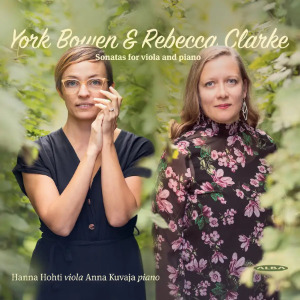
York Bowen (1884-1961)
Viola Sonata No.1 in C minor, Op.18 (1905)
Rebecca Clarke (1886-1979)
Viola Sonata (1919)
Hanna Hohti (viola)
Anna Kuvaja (piano)
rec. 2022, Järvenpää Church, Finland
Alba ABCD531 [52]
Coupling the sonatas of York Bowen and Rebecca Clarke is an astute move. The Bowen has received recordings, though not nearly as many as the Clarke, which is now a repertoire piece. So, it makes both repertorial and stylistic sense to contrast Bowen’s first, youthful sonata, an example of late romanticism, with Clarke’s more advanced one with its occasionally elliptical sophistication.
Bowen wrote the C minor sonata when he was 20 and performed it with Lionel Tertis, his champion. Violist Hanna Hohti has studied in London with James Boyd, who made a well-regarded recording of this sonata with Bengt Forsberg for Dutton many years ago. She doesn’t slavishly imitate his tempi and has her own thoughts on tempo relationships, catching the boldness of Bowen’s romanticist instincts at tighter tempi than Boyd in the first two movements. In fact, she and Anna Kuvaja remind me rather more of Doris Lederer and Jane Coop on Centaur. However, what’s lacking is a sense of richness of tone colour and phrasal know-how in this work, allied to a lack of real intimacy. So even in the finale, when the Finnish duo exude vibrancy the violist lacks Boyd’s sense of single-arch sweep and subtlety and indeed Lederer’s own more straightforward but highly effective sensibility.
The performance of the Clarke sonata is broadly good and most resembles Laurence Jackson and Martin Roscoe’s ASV recording. However, it lacks in the detailing, the subtle shifting sands of Clarke’s impressionist influences. To me, Tabea Zimmermann’s solutions remain the most effective, not least in the finale; allied to which she is the most tonally resplendent of the many violists who have recorded the work (her recording is on Myrios).
A single page at the back of the booklet tells us that there was a historically-informed emphasis to the programme. Kuvaja plays on an 1874 Pleyel grand piano – it’s springy with a brightness to it. I’m not wholly clear from the notes if Hohti is playing with a gut A string or whether she uses two gut and two metal or combinations thereof. In any case, this is rather fetishistic stuff. Surely the point is to play attractively on whatever strings and to balance well with the piano.
This is an adventurous programme and it’s reasonably performed by the two Finnish players but here we come to the deciding feature. The disc is saddled with an incessantly and ruinously hard recorded sound in Järvenpää Church. I’ve tried to tame it and it’s proved impossible; you have to keep the volume to an unreasonably low level. I am assuming – I could be wrong – that the engineers placed the microphones close to both instruments to mitigate the church acoustic but the results, to my ears, and even if the performances were magnificent (which they’re not – let’s be honest), rule this disc out of the running.
Jonathan Woolf
If you purchase this recording using a link below, it generates revenue for MWI and helps us maintain free access to the site



















